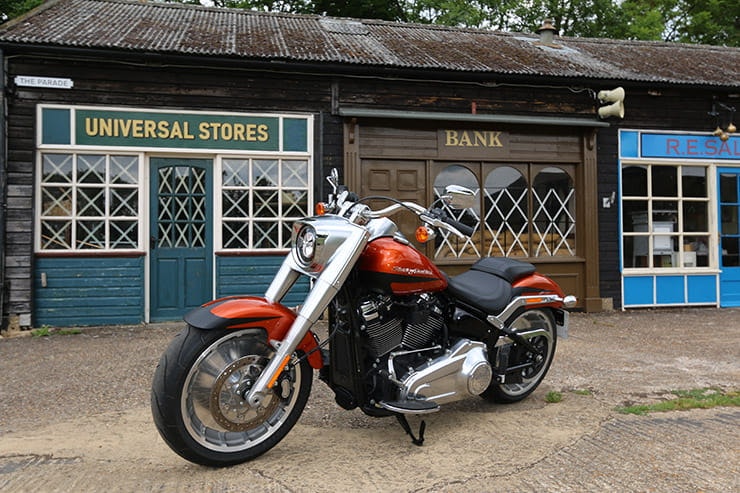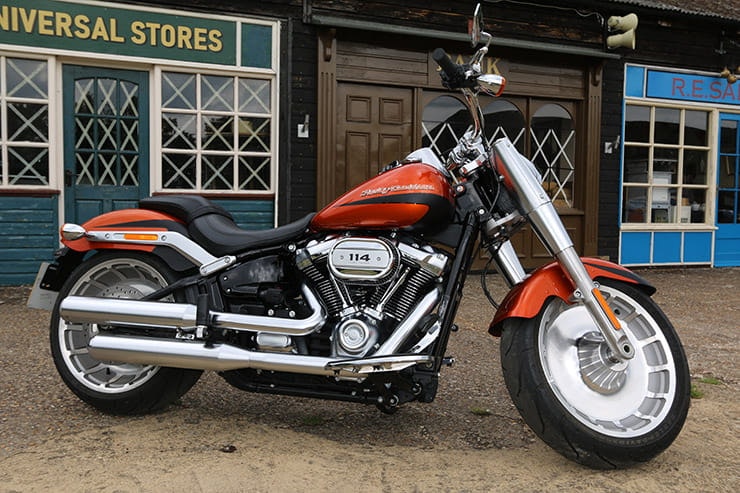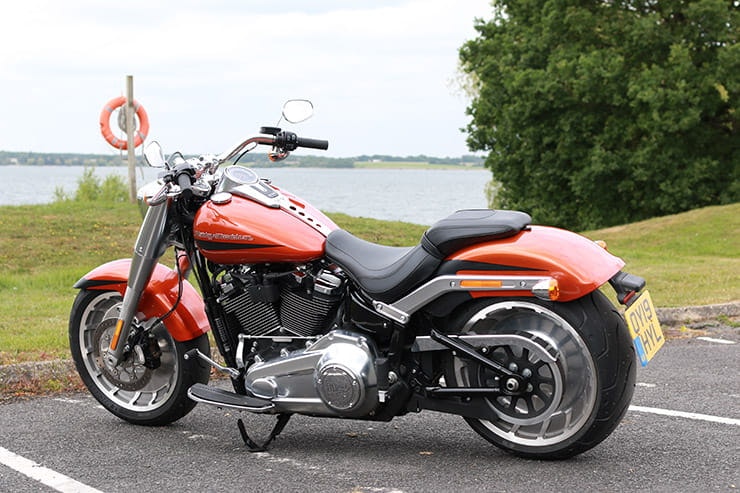Harley-Davidson Fat Boy 114 (2020) - Review
By Stephen Lamb
Production Manager
19.06.2020
In 1989, Harley-Davidson took a prototype custom bike to Daytona Bike Week. A pumped up soft-tail with solid wheels, wide bars, a shotgun exhaust and finished in matte grey, the bike was reputed to be styled on the B-29 bomber (used to deliver the 'Fat Man' A-Bomb on Hiroshima) and was fittingly given then title of 'Fat Boy'. Others argued that it took its styling cues from a steamroller, echoed in its wide track and exaggerated tyres. While the inspiration was unclear, what was immediately obvious was that Harley-Davidson had created a new style of bike and that people wanted a piece of the action.
The bike was put straight into production and when it hit the dealers in 1990 demand quickly outstripped supply.
When, in 1991, the Fat Boy made a starring appearance alongside Arnold Schwarzenegger in the hugely popular 'Terminator' sequel, the bad-boy status of this now iconic bike was assured.
30 years later and, having only receiving one major update, the Harley-Davison FLFBS Fat Boy still turns heads and delivers the kind of attitude that only American heavy-metal can. But is it all show and no go? We spent a couple of weeks with a 2020 model to find out.
The attitude – the Fat Boy truly is bad to the bone
The tsunami of torque
The looks – never have a I ridden a bike that makes so many people stop and stare
Not one for introverts
LCD screen is tiny (especially for anyone old enough to be able to afford the bike)
Faaaaat tyres – they look cool, but budget £400 plus fitting for a set
Listen carefully and you can hear George Thorogood & The Destroyers emanating from the exhaust pipes
HARLEY-DAVIDSON FLFBS FAT BOY 114 (2020) Price
Available with two engine sizes, the Fat Boy range starts at £17,545 for the 107 cubic inch (1753cc) in a solid colour. Add more colours and more 'cubes' and you end up at the 114 cubic inch (1868cc) in custom two-colour, as reviewed here, at £20,225, only topped by the limited-edition 30th anniversary model (in Terminator-esque black and copper) at £20,495.
By way of comparison, its nearest rivals, Triumph's Rocket 3 starts at £19,500 and Ducati's X-Diavel from £17,595. Against these, the Harley does seem overpriced (especially when we look at the rider-aids further down), but surely if you are buying a bike like the Fat Boy then that’s part of the attraction. Yes, it’s an extravagance, a treat, a splurge – call it what you want, but the purchase of a Fat Boy is a decision most certainly made with the heart, not the head.
As with all Harley-Davidsons, of course, the initial outlay on the bike could be the start of a very expensive journey, with nearly all aspects of the bike being tailorable through the (fully warranted) factory parts catalogue.
The smaller 107 engine is available but, come on, why would you?
Power and torque
On paper, the headline figure of 'just' 93bhp for an 1800cc, 317Kg bike seems woefully inadequate, but once you see the massive torque figure of 155Nm, and armed with some understanding of the relationship between power, torque and revs, it all begins to make sense.
Without getting to nerdy, and to massively over simplify, power can be defined as a product of the rotational force being applied to the crankshaft with each power-stroke (torque), and the number of power strokes applied over a set time (rpm). As we know that the engine makes huge torque, the limiting factor in developing equally huge power must be the limited rpm of the engine. Were the engine able to rev as high as the Ducati X-Diavel, for example (where max power it way up at 9250rpm), then we would see a hypothetical power figure of 160-165bhp – much closer that of the rivals. It's safe to say then that the Fat Boy is not underpowered, it just runs out of revs earlier than the others!
On the road (or rather on a track or private roads) this is evident when gunning for top speed where the bike stops pulling at just over an indicated ton.
In everyday riding though, the delivery of peak torque at 3000 rpm makes for strong acceleration just when you need it, and the almost flat torque curve means that there's almost as much grunt at tick-over as there is further up the range. As an experiment, I put the bike in second gear, closed the throttle and let the bike slow to a walking pace. The engine was revving barely above the idle speed yet maintained an even and smooth pace, with no hint of stall or judder.
Engine, gearbox and exhaust
While the big Milwaukee-Eight engine comes in two sizes, the figures are not that different between the two with the 107 down just 7 horses and 10 torques from the 114. With a difference of just over £1600 between the two (like-for-like), I think the bigger engine is the better choice, if for no other reason than bragging rights. Ordering a Fat Boy with an 'economy' engine choice is a bit like ordering a Big Mac with extra cheese, an extra patty and large fries, but a with diet Coke. If you are going large, make sure it counts!
The more I experience this engine, in 114 or 107 variants, the more impressed I am with it. It's smooth throughout the rev-range, but not clinically so, characterful without being uncompromising - the perfect blend of old school v-twin rumble and modern rideability and fuelling. It certainly goes a long way to dispelling the vibey image of Harleys of old.
The six-speed gearbox is equally smooth, both in initial gear selection and swapping cogs on the move, all despite a foot-long connector between the foot-forward selector lever and the gearbox. With minimal practice, clutchless shifts, both up and down can, be performed with ease.
The twin exhausts are subtle yet satisfying. While the temptation may be to sling the latest 120dB slash-cut cans on a bike like the Fat Boy, this could soon become tiresome. The standard twin exhausts look great, have the right provenance (they are subtly branded with the Screamin' Eagle logos) and yet, when in use, provide the right balance between road presence and long-term comfort.
D'oh - only one filler cap is real. Once full, you should see around 190 miles range
HARLEY-DAVIDSON FLFBS FAT BOY 114 (2020) Economy
Really? You are interested in fuel economy on a £20K 300Kg bike that screams "Look at me!!". Well good, because the official HD figure of 42mpg is a bit out (it's unclear if it refers to UK or US gallons for a start).
Having put just shy of 200 miles on the bike, on a variety of roads from twisty B-roads to the A1M motorway, and riding in a manner that I shall describe as less than sympathetic to fuel consumption, I managed to get just over 46mpg (46.3 to be exact) from the Fat Boy, giving a potential maximum range of around 195 miles from the 18.9 litre tank. For the size of engine and weight of the bike, I thanks that's impressive and, with a more cruiser-esque riding style, I would be confident in achieving a full 200 miles between fills – comfort allowing (see below). While this is nothing like the kind of economy that your will see from modern Japanese sports-tourers, it's a perfectly acceptable figure for a bike of such stature. I word to the wise though – while those twin fuel fillers on the top of the tank do look cool, only one is a real filler – the other does unscrew though, and would probably benefit from a touch or two of superglue to prevent loss.
Even on wet Motorways, you feel king of the road. Remote pre-load adjustment means quick and easy changes
Handling, suspension, chassis and weight
Let's address the elephant in the room straight away – the Fat Boy is a heavy bike. No matter how you dress it, an all up running weight of 317Kg is heavy (more than 1.5x the wet weight of a Yamaha Tracer 700 GT) and when man handling the low slung and wide bike around in the garage, for example, it feels every bit as heavy as you would imagine. But as soon as you sit down and take the bike off the side stand, the balance and low CofG mean that it feels like it instantly sheds 60-70 kilos. It'll never feel like a lightweight, but even for a 5'6" shorty like me, it gives a feeling of real confidence and stability at a stand-still. On the move, this balance and stability is almost amplified, allowing very low speed riding with ease and never feeling like the bike is about to fall in turns or catch you out on adverse cambers or blind junctions.
When it comes to pure handling (I'll address ride comfort later on) the bike once again surprises. When scanning the spec sheet before taking it out for the first time, I noticed the max lean-angle of just over 25°, and I have to admit was quite trepidatious in the first few turns for fear of scraping the footboards, but in practice, the lack of ground clearance isn't an issue. Maybe the low-sling riding position makes you ride a bit slower without realising, maybe I don’t really lean that far anyway, but on all but the most uneven of roads, the bike dispatched roundabouts with ease and remained (thankfully) scrape-free. Were I carrying a pillion and full luggage, I suspect that this would not be the case, but in these situations, the easily accessible rear-preload adjuster would allow some extra clearance to be dialled in.
Out of town and enjoying the sweeping B-roads that criss-cross Cambridgeshire's picturesque villages, the Fat Boy takes it all in its stride. Fast sweeping bends are dispatched with surprising ease and stability and even when the roads are more patch-work quilt than clean tarmac tramlining is minimal, considering the width of the tyres. Fast changes of direction do need some muscle-power, due to the wide front tyres, but the equally wide bars give plenty of leverage and it all makes for an involved and satisfying ride experience.
HARLEY-DAVIDSON FLFBS FAT BOY 114 (2020) Brakes
With just a single disc up front, you might think that it would struggle stopping nearly 400Kg of bike and rider in a hurry, but somehow, the Fat Boy pulls it off. The four-pot, H-D branded caliper does a great job of providing progressive and confident braking and, even on wet roads, never feels inadequate for the job in hand. The forward-mounted, large rubber pedal for the back brake is more car-like in aesthetics, but is equally well balanced and progressive. Coupled with the super-wide tyres and low centre of gravity, you need some serious abuse on the brakes to get the ABS to kick into life, which when activated, provides a smooth and predictable action with minimal judder.
A thoroughly enjoyable place to be
Comfort over distance and touring
As soon as you sit on the Fat Boy, you know you're in for a comfortable ride. The wide seat, wide handlebars, low seat position, feet forward controls and relaxed engine all make the Fat Boy a very nice place to be. While the wide tyres may make the handling that bit heavier, the effect they have on the plush ride is self-evident. They say the bike may have been styled on a steamroller and I think that also translates into the ride – never have Cambridgeshire's roads felt to smooth and pot-hole free. I was quite expecting to see cars following close behind, benefitting from the freshly flattened road in the wake in the Fat Boy.
After a couple of hours in the saddle, the riding position does begin to take its toll – your shoulders begin to ache from the wide handlebars, wind blast (the temptation to up your speed is always there) and heavy turning, your tailbone is acutely aware that all of your upper body weight is baring straight down into your hips and, despite the large and accommodating running boards, legs become fatigued from the low seat.
None of this is a deal-breaker – don’t get me wrong – but if you are planning some big-mile journeys, just make sure you plan in a few rest breaks over and above your scheduled fuel stops. If nothing else, it will give you a chance to sit a stare in lust at the bike and talk to the crowds that will inevitably come over to look at the bike.
Indicators are shared between the bars. Fire and forget - they self-cancel. LED lights add a modern touch.
Rider aids and extra equipment / accessories
For a bike in this class, and probably more pertinently, at this price point, rider aids are few are far between on the Fat Boy. Of course we get ABS front and rear, as you would expect from any bike built to Euro 4 regs, but there's no traction control for example (something that Harley-Davidson are slowly introducing, but via the Trike and Touring range first). We get keyless ignition, meaning we can avoid those embarrassing moments of taking ages putting gloves on, only to find the key's still in your pocket, and self-cancelling indicators, and… er that’s it.
That’s not to say the Fat Boy needs more rider aids. I'm not sure a quickshifter, for example, would be compatible with a cruiser – do you really need to shave milliseconds of your gear changes on bikes like these? The tiny LCD portion of the dash gives all the relevant information that you would expect, including trip, rev counter, range and gear indicator, but to be honest, mounted on the tank as it is, it's not the easiest display to read, even in ideal conditions.
You don't need a plethora of multi-stage, programmable, user-definable, 6-axis EMUable rider modes to enjoy riding the Fat Boy – just get on and ride. By the time your tech-savvy mates have finished fine tuning their semi-active suspension, got just the right amount of TCS and calibrated their lean angle monitors, you'll be a mile down the road, enjoying that v-twin throb and having a whale of a time. Less is more when it comes to Harleys and the Fat Boy in no exception.
When it comes to accessories though, more is more, and the range of trinkets, mods, extras and replacements is only limited by your imagination and your wallet. Nearly everything that can be unbolted from the bike can be changed to any number of alternatives along with all the added extras that you might feel is needed on such a bike including luggage, sissy bars, crash bars, highway pegs, bling etc.
Phwoarrr! What a beauty
HARLEY-DAVIDSON FLFBS FAT BOY 114 (2020) verdict
As the van pulled up outside my house to take the Fat Boy back to the Harley-Davison press fleet, I can honestly say, I was sad to see it go. Do I need a Fat Boy in my garage? No, of course not. Do I want one though? Hell-yes! The Fat Boy is everything that Harley-Davidsons should be – loud, brash, imposing, extreme and a crowd-puller wherever it goes. After spending some time with the Fat Boy, it comes as no surprise that the model has been in constant production since its introduction in 1990. Now, more than ever, in a world of lean-burn engines, three digit fuel consumption figures, zero emissions and hybrid technology, the Fat Boy gives us the chance to ride purely for the un-adulterated feeling of riding, and to do so in ultimate style.
Many thanks to The Camp, Ramsey for the backdrop for the photos.
HARLEY-DAVIDSON FLFBS FAT BOY 114 (2020) spec
Looking for motorcycle insurance? Get a quote for this motorbike with Bennetts bike insurance


